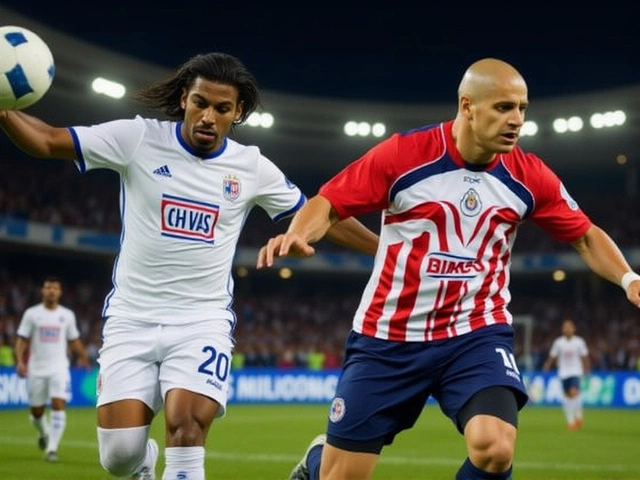When Paraguay beat Mexico 2-1 at the Alamodome on November 18, 2025, it wasn’t just another friendly. It was a wake-up call — and Mexico’s last game of the year. The match, played at 5:30 PM CST under the glow of San Antonio’s winter sky, ended with a stunning collapse in the final 10 minutes of the first half. Two goals in eight minutes, both by Antonio Sanabria and Damián Bobadilla, turned what looked like a tense but manageable contest into a sobering defeat. Even the penalty equalizer from Raúl Jiménez couldn’t save the day. For a team preparing for World Cup qualifiers in 2026, this loss isn’t just a setback — it’s a red flag.
A Night of Momentum Shifts
The first 45 minutes felt like a mirror of Mexico’s recent struggles: flashes of brilliance buried under indecision. Guillermo Ochoa Malagón, the veteran goalkeeper, looked sharp early, but his defense was constantly out of sync. Paraguay, meanwhile, played with a quiet confidence — no fireworks, just precision. Then, at the 48th minute, everything changed. Sanabria pounced on a loose ball after a cross from the left flank. The initial call was no goal — but VAR intervened. Broadcasters on Fox Deportes debated whether Malagón had been shoved, whether contact was excessive, whether it was even a foul at all. One commentator said, "It’s a 50-50 ball. He doesn’t show the studs. It’s a goal for Paraguay." The replay showed no clear foul. Just clean, brutal efficiency. The goal stood. Mexico’s defense, already shaky, seemed to exhale — and then collapsed.
The Eight-Minute Collapse
Just six minutes later, at the 54th, Jiménez buried a penalty after a handball in the box. For a moment, the Alamodome roared back to life. Mexico had life. But Paraguay didn’t flinch. At 56’, Bobadilla — a striker who barely made headlines before this match — turned a rebound off the post into a clinical finish. No drama. No celebration. Just a tap-in. The crowd fell silent. The Mexican bench looked stunned. "We weren’t able to create anything," one FMF State of Mind analyst wrote in their post-match analysis. "We were talking about his capacity and individual skills — but where was the system? The cohesion?"
It wasn’t just the goals. It was the timing. Eight minutes. Two goals. One penalty. That’s all it took. In the final minutes, Mexico pushed forward, desperate. Johan Vásquez conceded a corner at 90’+5’, but there was no urgency, no clarity. The final whistle at 90’+7’ didn’t feel like the end of a game — it felt like the end of an era.
Why This Matters Beyond the Scoreline
This wasn’t a tournament match. But it might be more telling than any World Cup qualifier. Mexico’s last game of 2025 — a neutral-site friendly against a CONMEBOL side — ended in defeat. And it wasn’t even close. Paraguay, ranked 45th in the world, outplayed a team that’s traditionally dominated CONCACAF. The lineup featured veterans like Ochoa and Jiménez, but also young players like Sebastián Córdova and Diego Lainez who failed to make an impact. The substitutes — Germán Berterame, Alexis Gutiérrez, César Montes — didn’t change the tide. They barely touched the ball.
What’s worse? The pattern. Mexico has now lost three of its last five friendlies against non-CONCACAF opponents. In 2024, they fell to Colombia and Uruguay. In 2023, they drew with Chile and lost to Japan. This isn’t bad luck. It’s a trend. And it’s happening at the worst possible time — with the 2026 World Cup, co-hosted by the U.S., Canada, and Mexico, just months away.
The Alamodome Effect
The Alamodome, a 65,000-seat venue in downtown San Antonio, was chosen as a neutral ground — a symbolic gesture to bring international soccer to American soil. But it also exposed Mexico’s growing disconnect with its fanbase. The crowd was mixed: Paraguayan expats, Mexican-American families, soccer purists. But when Bobadilla scored, the cheers weren’t just from the Paraguayan section. They were from the entire stadium. That’s not a sign of growing popularity — it’s a sign of diminishing trust.
For Mexico’s federation, the pressure is mounting. The Federación Mexicana de Fútbol (FMF) is under fire for inconsistent coaching, lack of youth integration, and a reliance on aging stars. "Alarm bells ring," their own article admitted. "Once again Mexico had a good first half..." — but that’s the problem. Good first halves don’t win tournaments. Consistent performance does.

What’s Next for Mexico?
The next competitive fixture for Mexico is a CONCACAF Nations League match in March 2026. But the real test comes in June — the World Cup opener against the United States in Dallas. If Mexico can’t fix their defensive lapses, their midfield inertia, and their inability to close out games, they won’t just be eliminated early — they’ll be embarrassed. The coaching staff has been given a reprieve, but only until the new year. Rumors are already swirling that the current manager, who took over in 2023, could be replaced before the World Cup.
Paraguay, meanwhile, leaves Texas with something they haven’t had in years: momentum. Sanabria, 27, has rediscovered his scoring touch. Bobadilla, 24, is now a household name in Asunción. Their coach, Erwin Sánchez, has quietly built a team that plays with grit, not flair. And in international soccer right now, grit wins.
Background: A History of Friendly Fiascos
Mexico has a long history of losing friendlies — especially against South American sides. In 2019, they lost 3-1 to Uruguay in a match that sparked a national outcry. In 2016, they were humiliated 4-0 by Brazil. But those were in Mexico City, where expectations are sky-high. This loss? In San Antonio? On neutral ground? That’s different. It suggests the problem isn’t just pressure — it’s preparation.
Paraguay, on the other hand, has been quietly rebuilding since their 2015 Copa América run. They’ve stopped relying on one superstar and started developing a collective identity. Their midfielders — not just their strikers — are now the engine. And that’s what makes this win so dangerous for Mexico’s future.
Frequently Asked Questions
Why did Mexico lose despite having better individual talent?
Mexico’s roster had more high-profile names — Jiménez, Ochoa, Lainez — but they lacked cohesion. Paraguay played as a unit, with midfielders tracking back and defenders stepping up. Mexico’s wingers drifted wide, their midfielders didn’t press, and their defense hesitated. Talent doesn’t win games; structure does. And Paraguay had more of it on display.
How did VAR influence the outcome of the match?
VAR confirmed Antonio Sanabria’s 48th-minute goal after initial uncertainty about contact with goalkeeper Guillermo Ochoa Malagón. While some fans believed Malagón was fouled, the review showed no clear foul — just a 50-50 challenge. That decision shifted momentum entirely. Without VAR, the goal might have been disallowed, and the match could have gone differently. But in modern soccer, VAR often decides more than just clear errors — it decides psychological momentum.
What does this loss mean for Mexico’s 2026 World Cup chances?
It’s a major warning sign. Mexico is co-hosting the 2026 World Cup, so they’re guaranteed a spot — but that doesn’t mean they’ll be competitive. Losing to Paraguay, a team with no World Cup qualification pressure, exposes their lack of tactical depth. If they can’t beat teams like this in friendlies, they’ll struggle against Brazil, Argentina, or even the U.S. in the group stage.
Why was this match played in San Antonio?
The Alamodome was chosen to test Mexico’s appeal in the U.S. market, especially among Mexican-American fans. It’s also a neutral venue — not home turf for either team — which makes the result more telling. The match drew over 50,000 fans, proving the demand is there. But the performance didn’t match the crowd’s expectations. The federation hoped for a showcase. Instead, they got a spotlight on their flaws.
Who were the key players for Paraguay in this match?
Antonio Sanabria, who scored the opening goal and was dangerous throughout, and Damián Bobadilla, whose finish sealed the win, were the stars. But the real unsung hero was their central midfielder, Diego Gómez, who won 12 duels and distributed 87% of his passes accurately. Paraguay didn’t win because of two goals — they won because their entire team outworked Mexico.
Is this defeat a sign that Mexico’s golden generation is over?
It’s not just about age — it’s about adaptation. Jiménez and Ochoa are still elite, but the players around them aren’t stepping up. The midfield lacks creativity, the defense lacks discipline, and the coaching staff hasn’t found a system that works. This isn’t the end of a generation — it’s the end of an era that hasn’t evolved. Without a radical overhaul, Mexico risks becoming a footnote in its own World Cup.




